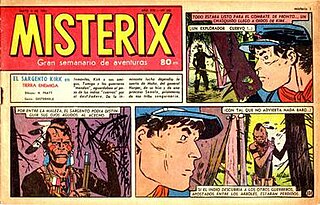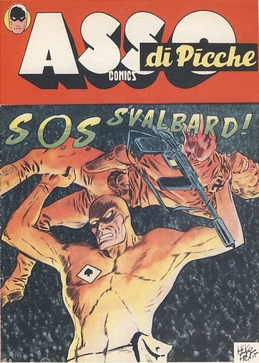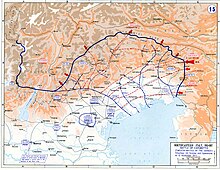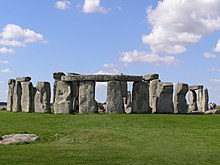
The Holy Grail is a treasure that serves as an important motif in Arthurian literature. Various traditions describe the Holy Grail as a cup, dish, or stone with miraculous healing powers, sometimes providing eternal youth or sustenance in infinite abundance, often guarded in the custody of the Fisher King and located in the hidden Grail castle. By analogy, any elusive object or goal of great significance may be perceived as a "holy grail" by those seeking such.

Giorgio Cavazzano is an Italian cartoonist, and one of the most famous Disney comics artists in the world.

Guinevere, also often written in Modern English as Guenevere or Guenever, was, according to Arthurian legend, an early-medieval queen of Great Britain and the wife of King Arthur. First mentioned in popular literature in the early 12th century, nearly 700 years after the purported times of Arthur, Guinevere has since been portrayed as everything from a fatally flawed, villainous and opportunistic traitor to a noble and virtuous lady. Many records of the legend also feature the variably recounted story of her abduction and rescue as a major part of the tale.

Vortigern, also spelled Vortiger, Vortigan, Voertigern and Vortigen, was a 5th-century warlord in Britain, known perhaps as a king of the Britons or at least connoted as such in the writings of Bede and Gildas. His existence is contested by scholars and information about him is obscure.

Oberon is a king of the fairies in medieval and Renaissance literature. He is best known as a character in William Shakespeare's play A Midsummer Night's Dream, in which he is King of the Fairies and spouse of Titania, Queen of the Fairies.

Corto Maltese is a series of adventure comics named after the character Corto Maltese, an adventurous sailor. It was created by the Italian comic book creator Hugo Pratt in 1967. The comics are highly praised as some of the most artistic and literary graphic novels ever written and have been translated into numerous languages and adapted into several animated films.

Ugo Eugenio Prat, better known as Hugo Pratt, was an Italian comic book creator who was known for combining strong storytelling with extensive historical research on works such as Corto Maltese. He was inducted into the Will Eisner Award Hall of Fame in 2005, and was awarded the 15th anniversary special Grand Prix de la ville d'Angoulême at the Angoulême Festival. In 1946 Hugo Pratt became part of the so-called Group of Venice with Fernando Carcupino, Dino Battaglia and Damiano Damiani.

Culhwch and Olwen is a Welsh tale that survives in only two manuscripts about a hero connected with Arthur and his warriors: a complete version in the Red Book of Hergest, c. 1400, and a fragmented version in the White Book of Rhydderch, c. 1325. It is the longest of the surviving Welsh prose tales. Lady Charlotte Guest included this tale among those she collected under the title The Mabinogion.

Sergeant Kirk or Sgt. Kirk is the main character of the Western comics series of the same title by Italian comic book creator Hugo Pratt and Argentine author Héctor Germán Oesterheld.

In Arthurian legend, Ywain, also known as Yvain and Owain among other spellings, is a Knight of the Round Table. Tradition often portrays him as the son of King Urien of Gorre and of either the enchantress Modron or the sorceress Morgan le Fay. The historical Owain mab Urien, the basis of the literary character, ruled as the king of Rheged in Britain during the late-6th century.

Celtic literature is the body of literature written in one of the Celtic languages, or else it may popularly refer to literature written in other languages which is based on the traditional narratives found in early Celtic literature.

linus is an Italian comics magazine published in Italy since 1965. It is the first Italian magazine exclusively focused on comics. During a period of crisis, the magazine was not published in May and June 2013, but returned in July, published by Baldini & Castoldi.
Nantier Beall Minoustchine Publishing Inc. is an American graphic novel publisher. Founded by Terry Nantier in 1976 as Flying Buttress Publications, NBM is one of the oldest graphic novel publishers in North America. The company publishes English adaptations and translations of popular European comics, compilations of classic comic strips, and original fiction and nonfiction graphic novels. In addition to NBM Graphic Novels, the company has several imprints including ComicsLit for literary graphic fiction, and Eurotica and Amerotica for adult comics.

The myth of the Seven Cities of Gold, also known as the Seven Cities of Cíbola, was popular in the 16th century and later featured in several works of popular culture. According to legend, the seven cities of gold referred to Aztec mythology revolving around the Pueblos of the Spanish Nuevo México, modern New Mexico and Southwestern United States.
Sir Gawain and the Carle of Carlisle is a Middle English tail-rhyme romance of 660 lines, composed in about 1400. A similar story is told in a 17th-century minstrel piece found in the Percy Folio and known as The Carle of Carlisle. These are two of a number of early English poems that feature the Arthurian hero Sir Gawain, the nephew of King Arthur, in his English role as a knight of the Round Table renowned for his valour and, particularly, for his courtesy.

In folklore and literature, the Fairy Queen or Queen of the Fairies is a female ruler of the fairies, sometimes but not always paired with a king. Depending on the work, she may be named or unnamed; Titania and Mab are two frequently used names. Numerous characters, goddesses or folkloric spirits worldwide have been labeled as Fairy Queens.

Asso di Picche was an Italian comic series featuring an eponymous masked crime fighter who combats an international crime syndicate known as the Band of Panthers. The action occurs all over the world, but chiefly in a dark, melancholic version of San Francisco. It was created in 1945 by Mario Faustinelli, Alberto Ongaro and Hugo Pratt. Editorial work was by Faustinelli and Ongaro wrote the text, while Pratt did the initial pencil drawings which were later revised in ink by Faustinelli. It was concluded in 1949.

The Land of Maidens is a motif in Irish mythology and medieval literature, especially in the chivalric romance genre. The latter often also features a castle instead of an island, sometimes known as the Castle of Maidens.

The Ballad of the Salty Sea is a graphic novel, the first episode of the adventures of Corto Maltese, a Maltese sailor. This story was written and drawn by the Italian comic book creator Hugo Pratt. It was published for the first time between 1967 and 1969, in the magazine Il Sergente Kirk. It takes place in Melanesia, shortly before World War I, between 1913 and 1915. It introduces many future important characters from the series, such as the romantic Corto, the crazy Russian sailor Rasputin, and the young cousins Pandora and Cain.

The Golden House of Samarkand is a graphic novel, episode of Corto Maltese's adventures, a Maltese sailor. He lives a long journey from the Mediterranean Sea to the heart of Asia, between December 1921 and September 1922. This story was written and drawn by the Italian comic book creator Hugo Pratt. This is the twenty-sixth story and eighth album in the series. It was published for the first time in 1980.





























